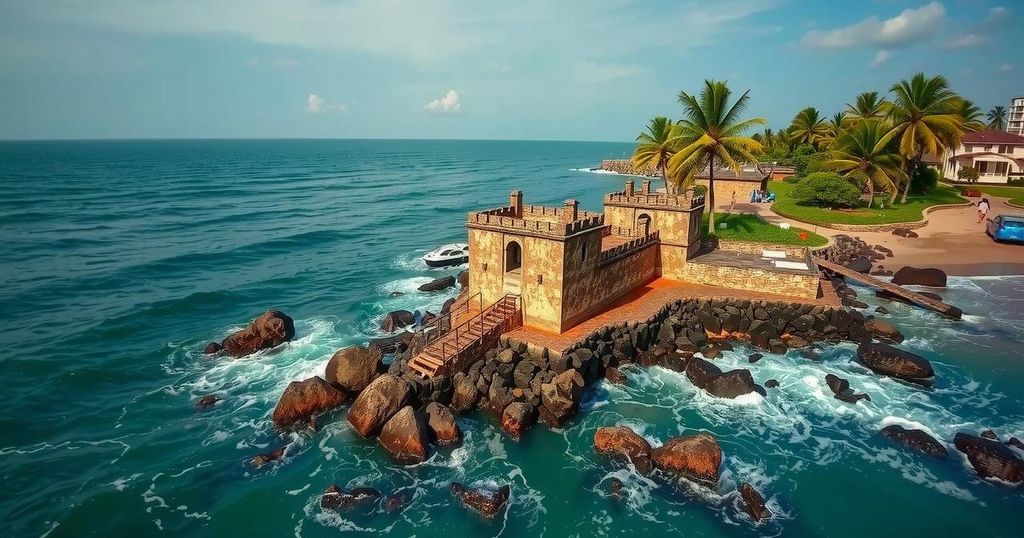Ghana’s Historic Coastal Forts at Risk: A Consequence of Climate Change
Ghana is losing historic forts along its coastline due to severe tidal waves and coastal erosion linked to climate change, with significant losses occurring annually. Key sites such as Fort Prinzenstein and Fort Kongenstein have succumbed to rising sea levels, prompting concerns for both local communities and cultural heritage. Ongoing mitigation efforts include the development of coastal defense walls and resilience investment projects funded by international partners.
Ghana is facing a significant loss of its historic coastal forts along the 550-kilometer coastline, as intense tidal waves from the Atlantic Ocean wreak havoc on these monuments. The coastal erosion phenomenon has led to the annual loss of approximately two meters of coastline, with some locations experiencing losses of up to 17 meters. This environmental crisis not only jeopardizes the livelihoods of local communities but also threatens the country’s rich history, particularly its slave forts and castles built over two centuries ago. Among the most affected is the 240-year-old Fort Prinzenstein located in Keta, in the Volta Region, which, once a robust fortress, now finds two-thirds of its structure submerged beneath the ocean due to relentless tidal waves. James Ocloo Akorli, the fort’s caretaker, stated, “Eight of its ten dungeons, originally built to hold enslaved Africans during the trans-Atlantic slave trade, were completely submerged before a sea defense wall was erected to protect what remains of the monument.” Furthermore, Fort Kongenstein, an 18th-century structure in Ada, Greater Accra Region, no longer exists, as it has been completely washed away by the rising tides. Similarly, Fort Fredensborg in Old Ningo has diminished to a mere remnant of its former self over its 289 years of existence. Joyce Ayorkor Guddah, the Tourism and Culture Officer in Ningo Prampram, noted with concern that “Fort Vernon has become a death trap, as the tidal waves have severely damaged it.” Coastal communities along the Western and Volta Regions are also in dire straits, facing relocation and potential extinction. Akorli Simon, a former resident of Fuveme, recounted the tragedy of his abandoned community after intense tidal surges eroded their land beyond recovery. Residents have sought refuge in nearby areas such as Dzakplagbe, where they fear a similar fate could befall them. In the Western Region, Anlo village has been severely compromised, reduced to a narrow stretch caught between the sea and the expanding lagoon fed by the River Pra. In Accra’s Glefe suburb, many residents are fleeing their homes due to the destruction caused by tidal waves. To combat the urgent challenges posed by coastal erosion, significant interventions are underway. The construction of the 8.3-kilometer Keta Sea Defence Wall, initiated more than a decade ago with financial backing from the United States Export-Import Bank at a cost of $94 million, aims to shield the coastline from encroaching waters. Additionally, the West Africa Coastal Areas Resilience Investment Project, Ghana 2, seeks to bolster resilience along Ghana’s coastlines while preserving essential coastal ecosystems. The Minister of Environment, Science, Technology, and Innovation, Ophelia Mensah Hayford, highlighted funding from the World Bank for this $155 million initiative, which will address longstanding issues of tidal surges, flooding, pollution, and erosion in sensitive areas such as the Korle Lagoon, Densu Basin, and Keta Lagoon.
Ghana’s coastline is witnessing alarming environmental degradation due to climate change, manifesting as severe coastal erosion and rising sea levels. This phenomenon poses a dual threat to both local communities and historically significant structures along the coast. The historic forts, which served as pivotal sites during the trans-Atlantic slave trade, are now endangered, revealing the intersection of environmental and cultural preservation challenges. The ongoing loss reinforces the urgency for effective intervention strategies to combat further deterioration and protect both living environments and cultural heritage.
In conclusion, Ghana’s coastline is under serious threat from climate change, with historic forts and coastal communities at heightened risk of extinction. The loss of structures such as Fort Prinzenstein and Fort Kongenstein highlights the urgency of intervention efforts. While projects like the Keta Sea Defence Wall and the West Africa Coastal Areas Resilience Investment Project represent significant steps toward mitigating these challenges, the future safety of the coastline and its communities hinges on continued efforts and commitment to climate change resilience and heritage preservation.
Original Source: www.rfi.fr




Post Comment